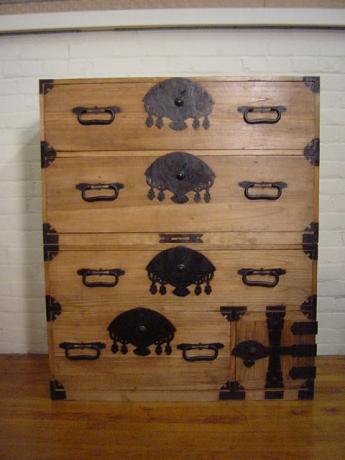Japanese Cabinets are the epitome of chic simplicity. To find out what type of Japanese cabinet would best suit your dining room interior read on…
Many Americans are confused by oriental furniture styles, but the hallmark of Japanese furniture is simplicity. Clean lines and minimal decoration make Japanese cabinets a perfect marriage with modern décor. Chinese and Korean furniture often feature heavy brass, inlaid surfaces and paintings that are not commonly seen on Japanese china cabinets. The definitive Japanese piece, the tansu cabinet, can be modified for use in dining rooms as a china cabinet.
Tansu Cabinets
A tansu cabinet features steps on one or both sides and has the appearance of modular boxes although it is all one piece. Most tansu cabinets have closed storage, but the steps are a great place to display figurines, small sculptures, artwork and collectables. The china cabinet is not a traditional Japanese piece of furniture, but Japanese furniture designers have added their own style to this European item.
Many Japanese china cabinets feature glass doors on the top part of the cabinet, but unlike traditional American and European china cabinets, the Japanese cabinets feature doors that slide back an forth rather than hinged doors. Some have small panes of glass with woodwork in between the panes while others are simply unframed glass. Traditional Japanese furniture is sometimes finished in lacquer, although natural wood finishes are more common.
The clean geometric lines of Japanese furniture makes it a hit with people who love art deco or modern decorating styles. In most cases, finishes are dark, although red lacquer is also fairly common. Small brass hinges and door or drawer pulls may also be used on Japanese china cabinets and sometimes antique brass is used to make these accoutrements less conspicuous. The style of Japanese furniture is understated with few decorative elements.
While many of their Asian neighbors favor furniture pieces with elaborate carving, inlay or decoration, these elements are an anathema to most Japanese furniture designers who keep surfaces flat, clean and free of unnecessary decorative touches. Balance and symmetry are important elements, but the key to Japanese design is simplicity. China cabinets are not traditional in Japan since ostentatious display is usually considered in poor taste. Beautiful tea sets and dishes are stored away except when in use.
When arranging a display in a Japanese china cabinet it is best to keep the design simple and uncrowded. Most Japanese decorating is open and airy allowing each item to shine individually while remaining part of a harmonious whole. For those with a desire for clean lines and simple elegance, a Japanese china cabinet may be just the right touch.





